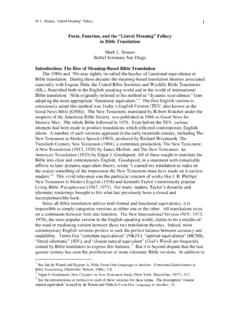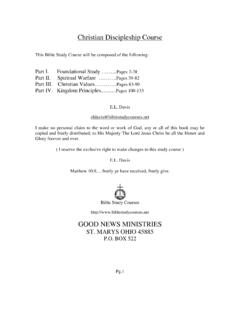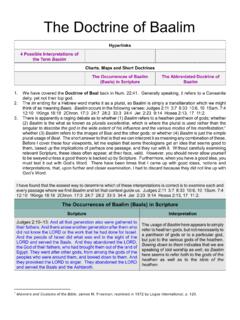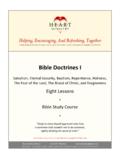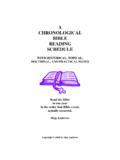Transcription of Solo Scriptura: The Difference a Vowel Makes - AgeeCreative
1 solo scriptura . solo scriptura The Difference a Vowel Makes by Keith A. Mathison Modern Reformation 16/2 (March/April 2007), pp. 25-29. The twentieth century could, with some accuracy, be called a century of theological anarchy. Liberals and sectarians have long rejected outright many of the fundamental tenets of Christian orthodoxy. But more recently professing evangelical scholars have advocated revisionary versions of numerous doctrines. A revisionary doctrine of God has been advocated by proponents of openness theology. A revisionary doctrine of eschatology has been advocated by proponents of full-preterism.
2 Revisionary doctrines of justification sola fide have been advocated by proponents of various new perspectives on Paul. Often the revisionists will claim to be restating a more classical view. Critics, however, have usually been quick to point out that the revisions are actually distortions. Ironically, a similarly revisionist doctrine of sola scriptura has arisen within Protestantism, but unlike the revisionist doctrine of sola fide, the revisionist doctrine of sola scriptura has caused very little controversy among the heirs of the Reformation.
3 One of the reasons there has been much less controversy over the revisionist doctrine of sola scriptura is that this doctrine has been gradually supplanting the Reformation doctrine for centuries. In fact, in many segments of the evangelical world, the revisionist doctrine is by far the predominant view now. Many claim that this revisionist doctrine is the Reformation doctrine. However, like the revisionist doctrines of sola fide, the revisionist doctrine of sola scriptura is actually a distortion of the Reformation doctrine. The adoption of the revisionist doctrine of sola scriptura has resulted in numerous biblical, theological, and practical problems within Protestant churches.
4 These problems have become the center of attention in recent years as numerous Protestants have converted to Roman Catholicism and Eastern Orthodoxy claiming that their conversion was due in large part to their determination that the doctrine of sola scriptura was indefensible. Roman Catholic and Eastern Orthodox apologists have been quick to take advantage of the situation, publishing numerous books and articles devoted to critiquing the doctrine of sola scriptura . One issue, however, that neither the converts nor the apologists seem to understand is that the doctrine they are critiquing and rejecting is the revisionist doctrine of sola scriptura , not the classical Reformation doctrine.
5 In order to understand the Difference , some historical context is necessary. 1. solo scriptura . Historical Observations Part of the difficulty in understanding the Reformation doctrine of sola scriptura is due to the fact that the historical debate is often framed simplistically in terms of Scripture versus tradition. Protestants are said to teach Scripture alone, while Roman Catholics are said to teach Scripture plus tradition. This, however, is not an accurate picture of the historical reality. The debate should actually be understood in terms of competing concepts of the relationship between Scripture and tradition, and there are more than two such concepts in the history of the church.
6 In order to understand the Reformation doctrine of sola scriptura we must understand the historical context more accurately. The Reformation debate over sola scriptura did not occur in a vacuum. It was the continuation of a long-standing medieval debate over the relationship between Scripture and tradition and over the meaning of tradition itself. In the first three to four centuries of the church, the church fathers had taught a fairly consistent view of authority. The sole source of divine revelation and the authoritative doctrinal norm was understood to be the Old Testament together with the Apostolic doctrine, which itself had been put into writing in the New Testament.
7 The Scripture was to be interpreted in and by the church within the context of the regula fidei ( rule of faith ), yet neither the church nor the regula fidei were considered second supplementary sources of revelation. The church was the interpreter of the divine revelation in Scripture, and the regula fidei was the hermeneutical context, but only Scripture was the Word of God. Heiko Oberman (1930-2001) has termed this one-source concept of revelation Tradition 1.. The first hints of a two-source concept of tradition, a concept in which tradition is understood to be a second source of revelation that supplements biblical revelation, appeared in the fourth century in the writings of Basil and Augustine.
8 Oberman terms this two-source concept of tradition Tradition 2 (Professor Oberman had many gifts. The ability to coin catchy labels was apparently not one of them). It is not absolutely certain that either Basil or Augustine actually taught the two-source view, but the fact that it is hinted at in their writings ensured that it would eventually find a foothold in the Middle Ages. This would take time, however, for throughout most of the Middle Ages, the dominant view was Tradition 1, the position of the early church. The beginnings of a strong movement toward Tradition 2 did not begin in earnest until the twelfth century.
9 A turning point was reached in the fourteenth century in the writings of William of Ockham. He was one of the first, if not the first, medieval theologian to embrace explicitly the two-source view of revelation. From the fourteenth century onward, then, we witness the parallel development of two opposing views: Tradition 1 and Tradition 2. It is within the context of this ongoing medieval debate that the Reformation occurred. When the medieval context is kept in view, the Reformation debate over sola scriptura becomes much clearer. The reformers did not invent a new doctrine out of whole cloth.
10 They were continuing a debate that had been going on for centuries. They were reasserting Tradition 1 within their particular historical context to combat the results of Tradition 2. within the Roman Catholic Church. The magisterial reformers argued that Scripture was the sole source of revelation, that it is to be interpreted in and by the church, and that it is to be interpreted within the context of the regula fidei. They insisted on returning to the ancient doctrine, and as Tradition 1 became more and more identified with their Protestant cause, 2.
